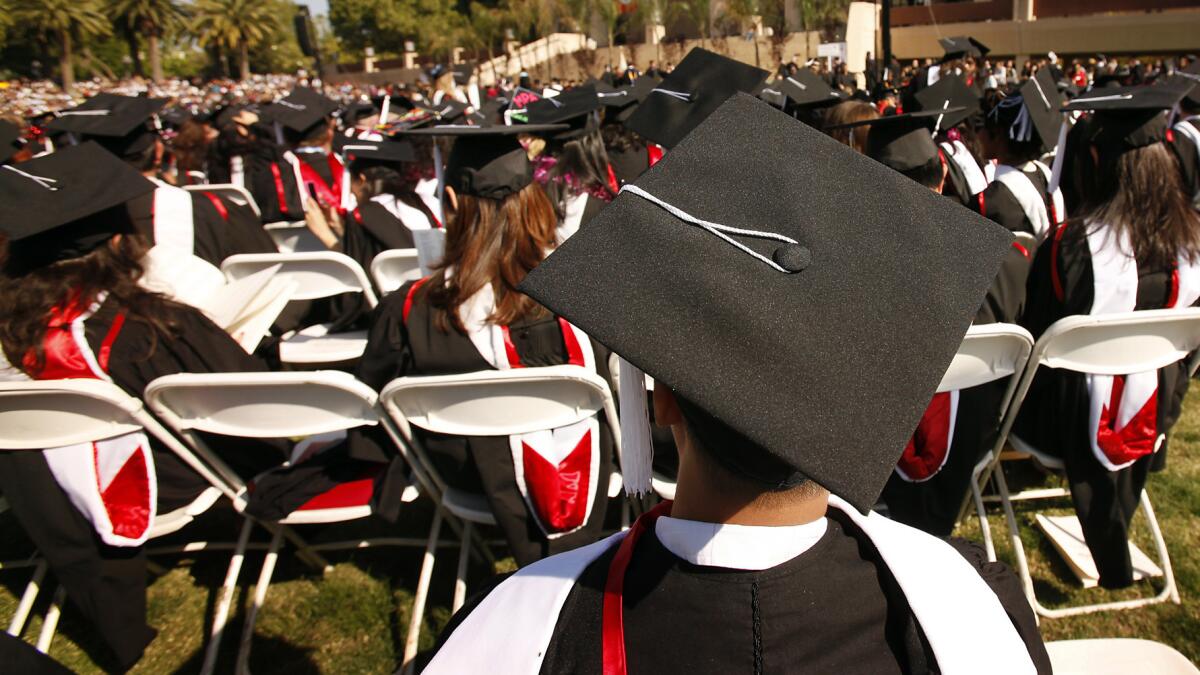Cal State can’t rely on out-of-state students for a revenue boost. Here’s what it does instead

Commencement ceremonies at Cal State Northridge.
- Share via
As the leader of a large public university system, Timothy P. White said he can understand why the University of California decided to boost its revenue by admitting more students from out of state.
A so-called nonresident student pays about $25,000 more in UC tuition and fees each year than a student from California. Given the deep cuts to higher education since the 2008 recession, the temptation is clear, White said.
But as chancellor of the California State University system, White said he can’t rely on out-of-state students to help make ends meet. Most of the schools in the 23-campus system don’t attract many applicants from outside California, he said Wednesday in a meeting with The Times editorial board.
See the most-read stories this hour >>
Instead, the nation’s largest public university system copes with its financial crunch by turning away tens of thousands of qualified students, White said.
Budget-wise, “we’re still about $135 million below where we were in 2008,” he said.
Enrollment throughout the system has increased by about 20,000 since then, but it hasn’t been enough to make room for everyone who wants to attend a Cal State school, White said. About 30,000 applicants who fulfilled all the admissions requirements last fall got rejection letters anyway.
When a qualified UC applicant can’t get into the campus of his or her choice, he or she will be offered a seat at UC Merced. There is no equivalent deal at CSU, said White, who previously served as chancellor of UC Riverside.
For a variety of family and financial reasons, Cal State students typically live close to home. So although a campus like CSU Channel Islands in Camarillo has room for more students, that’s simply not a practical option for someone who lives in Northridge, he said.
It’s a tough situation, White said. For decades, Cal State relied on the state to pay for the vast majority of public higher education costs. Now, state general funds cover about half these costs; tuition and fees cover the rest.
Tuition has doubled after pre-recession levels, but it has remained flat since 2011 and will remain that way next year as part of a funding agreement with Gov. Jerry Brown.
The same financial pressures have prevented administrators from granting Cal State faculty the 5% raise they have been seeking for about a year, White said. This year, there’s room in the budget for a 2% raise, with additional increases in the future.
An independent mediator released a report Monday that sided with the California Faculty Assn. and said a 5% raise was warranted. About 26,000 professors, lecturers, librarians, counselors and coaches will strike next month if a deal isn’t reached.
White, a former professor of human biodynamics, said he was sympathetic to the faculty union’s position and would continue talks to try and find a solution. The challenge, he said, is balancing faculty compensation against the costs of higher enrollment, academic support programs and much-needed maintenance and upgrades to buildings and technology.
Ultimately, every one of Cal State’s top priorities is underfunded, he said. It’s a scenario where none of the choices is ideal.
“What is the least lousy decision to make?” White said.
Follow @RosannaXia for more education news.
MORE FROM EDUCATION
20 high school swimmers rescued off La Jolla
Former USC chief Steven Sample is remembered for his deep faith
Michelle Rhee’s StudentsFirst will merge with education advocacy group 50Can
More to Read
Sign up for Essential California
The most important California stories and recommendations in your inbox every morning.
You may occasionally receive promotional content from the Los Angeles Times.











